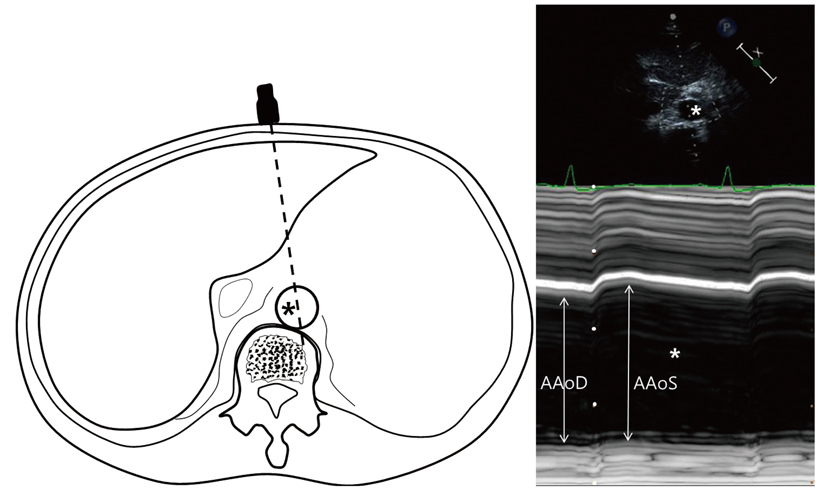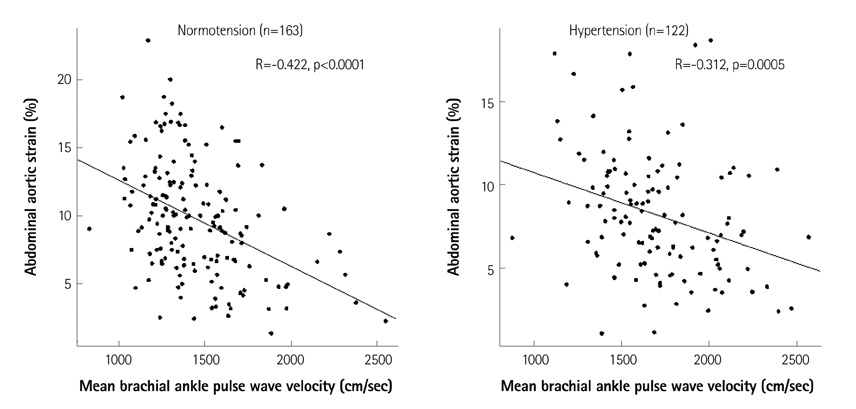Korean Circ J.
2013 Jun;43(6):391-399. 10.4070/kcj.2013.43.6.391.
Correlation between Proximal Abdominal Aortic Stiffness Measured by Ultrasound and Brachial-Ankle Pulse Wave Velocity
- Affiliations
-
- 1Division of Cardiology, Department of Internal Medicine, Hanyang University College of Medicine, Seoul, Korea. jhs2003@hanyang.ac.kr
- 2Department of General Surgery, Shatin Central Hospital, Ulaanbaatar, Mongolia.
- KMID: 2224900
- DOI: http://doi.org/10.4070/kcj.2013.43.6.391
Abstract
- BACKGROUND AND OBJECTIVES
The proximal portion of the abdominal aorta (AA) is characterized by minimal arteriosclerosis compared with other aortic segments. To assess the clinical usefulness of this characteristic, the correlation between ultrasonographically measured proximal AA stiffness and brachial-ankle pulse wave velocity (baPWV) was examined.
SUBJECTS AND METHODS
285 subjects were analyzed, half with hypertension and half with normal blood pressure. Proximal AA was examined using ultrasonography; strain, distensibility, elastic modulus, and the stiffness index were determined. After adjustment for age, gender, body mass index (BMI), systolic blood pressure (SBP), and heart rate, the relationships between baPWV and all these parameters were tested.
RESULTS
The mean age of the study subjects was 58.1+/-12.8 years and the mean BMI was 24.3+/-3.8 kg/cm2. 58.9% of the subjects were female. 42.8% were hypertensive subjects. Among the hypertensive subjects, 56.0% were taking antihypertensive medication. Adjusted partial correlation coefficients for the relationship between baPWV with strain, distensibility, elastic modulus, and the stiffness index of the proximal AA were -0.203 (p=0.01), -0.121 (p=0.129), 0.304 (p=0.0001), and 0.299 (p=0.0001), respectively, in normotensive subjects. In the multivariate analyses, such correlations were observed mainly in the normotensive group, whereas there was no association among hypertensive subjects regardless of antihypertensive medication status.
CONCLUSION
baPWV is moderately correlated with the stiffness parameters for the proximal AA, mainly in normotensive subjects.
MeSH Terms
Figure
Cited by 1 articles
-
Clinical Significance and Therapeutic Implication of Nocturnal Hypertension: Relationship between Nighttime Blood Pressure and Quality of Sleep
Myeong-Chan Cho
Korean Circ J. 2019;49(9):818-828. doi: 10.4070/kcj.2019.0245.
Reference
-
1. Laurent S, Boutouyrie P, Asmar R, et al. Aortic stiffness is an independent predictor of all-cause and cardiovascular mortality in hypertensive patients. Hypertension. 2001; 37:1236–1241.2. Kolipaka A, Woodrum D, Araoz PA, Ehman RL. MR elastography of the in vivo abdominal aorta: a feasibility study for comparing aortic stiffness between hypertensives and normotensives. J Magn Reson Imaging. 2012; 35:582–586.3. Kim MJ, Lee SY, Kim YB, Kil HR. Click here to read click here to read clinical significance of the mechanical properties of the abdominal aorta in Kawasaki disease. Korean J Pediatr. 2008; 51:1012–1017.4. Nakamura U, Iwase M, Nohara S, Kanai H, Ichikawa K, Iida M. Usefulness of brachial-ankle pulse wave velocity measurement: correlation with abdominal aortic calcification. Hypertens Res. 2003; 26:163–167.5. Okubo M, Ino T, Takahashi K, Kishiro M, Akimoto K, Yamashiro Y. Age dependency of stiffness of the abdominal aorta and the mechanical properties of the aorta in Kawasaki disease in children. Pediatr Cardiol. 2001; 22:198–203.6. Haskett D, Johnson G, Zhou A, Utzinger U, Vande Geest J. Microstructural and biomechanical alterations of the human aorta as a function of age and location. Biomech Model Mechanobiol. 2010; 9:725–736.7. Ahlgren AR, Hansen F, Sonesson B, Länne T. Stiffness and diameter of the common carotid artery and abdominal aorta in women. Ultrasound Med Biol. 1997; 23:983–988.8. Seo JS, Lee SY, Kim HD. Quantitative analysis of aortic atherosclerosis in Korean female: a necropsy study. J Korean Med Sci. 2007; 22:536–545.9. Zakai NA, Katz R, Jenny NS, et al. Inflammation and hemostasis biomarkers and cardiovascular risk in the elderly: the Cardiovascular Health Study. J Thromb Haemost. 2007; 5:1128–1135.10. Kaibe M, Ohishi M, Komai N, et al. Arterial stiffness index: a new evaluation for arterial stiffness in elderly patients with essential hypertension. Geriatr Gerontol Int. 2002; 2:199–205.11. Giannattasio C, Capra A, Facchetti R, et al. Relationship between arterial distensibility and coronary atherosclerosis in angina patients. J Hypertens. 2007; 25:593–598.12. Gur M, Yilmaz R, Demirbag R, et al. Relationship between myocardial performance index and aortic distensibility in patients with essential hypertension. Int J Clin Pract. 2008; 62:138–142.13. Dernellis J, Panaretou M. Aortic stiffness is an independent predictor of progression to hypertension in nonhypertensive subjects. Hypertension. 2005; 45:426–431.14. Gosling RG, Budge MM. Terminology for describing the elastic behavior of arteries. Hypertension. 2003; 41:1180–1182.15. Kawasaki T, Sasayama S, Yagi S, Asakawa T, Hirai T. Non-invasive assessment of the age related changes in stiffness of major branches of the human arteries. Cardiovasc Res. 1987; 21:678–687.16. Pitsavos C, Toutouzas K, Dernellis J, et al. Aortic stiffness in young patients with heterozygous familial hypercholesterolemia. Am Heart J. 1998; 135:604–608.17. Stefanadis C, Stratos C, Boudoulas H, Kourouklis C, Toutouzas P. Distensibility of the ascending aorta: comparison of invasive and noninvasive techniques in healthy men and in men with coronary artery disease. Eur Heart J. 1990; 11:990–996.18. Pannier BM, Avolio AP, Hoeks A, Mancia G, Takazawa K. Methods and devices for measuring arterial compliance in humans. Am J Hypertens. 2002; 15:743–753.19. Shin J, Lee J, Lim HK, Lee BH, Kim MK, Choi BY. The relationship between the pulse wave velocity (PWV) and the left ventricular geometry: a Community-Based Cross-Sectional Study. Korean Circ J. 2005; 35:683–689.20. Erdogan D, Gullu H, Caliskan M, et al. The influence of circadian blood pressure changes on aortic distensibility and left ventricular diastolic function in hypertensive individuals. Int J Cardiovasc Imaging. 2006; 22:157–165.21. Lee YS, Kim KS, Hyun DW, et al. The change of arterial stiffness according to dialysis in patients with end-stage renal disease. Korean Circ J. 2004; 34:865–873.22. Faul F, Erdfelder E, Buchner A, Lang AG. Statistical power analyses using G*Power 3.1: tests for correlation and regression analyses. Behav Res Methods. 2009; 41:1149–1160.23. Ito N, Ohishi M, Takagi T, et al. Clinical usefulness and limitations of brachial-ankle pulse wave velocity in the evaluation of cardiovascular complications in hypertensive patients. Hypertens Res. 2006; 29:989–995.24. Hung CS, Lin JW, Hsu CN, et al. Using brachial-ankle pulse wave velocity to associate arterial stiffness with cardiovascular risks. Nutr Metab Cardiovasc Dis. 2009; 19:241–246.25. Li B, Gao H, Li X, Liu Y, Wang M. Correlation between brachial-ankle pulse wave velocity and arterial compliance and cardiovascular risk factors in elderly patients with arteriosclerosis. Hypertens Res. 2006; 29:309–314.26. Redheuil A, Yu WC, Wu CO, et al. Reduced ascending aortic strain and distensibility: earliest manifestations of vascular aging in humans. Hypertension. 2010; 55:319–326.27. Tsamis A, Rachev A, Stergiopulos N. A constituent-based model of age-related changes in conduit arteries. Am J Physiol Heart Circ Physiol. 2011; 301:H1286–H1301.28. Lehmann ED, Gosling RG, Parker JR, deSilva T, Taylor MG. A blood pressure independent index of aortic distensibility. Br J Radiol. 1993; 66:126–131.29. Regnault V, Thomas F, Safar ME, et al. Sex difference in cardiovascular risk: role of pulse pressure amplification. J Am Coll Cardiol. 2012; 59:1771–1777.30. Dart AM, Kingwell BA, Gatzka CD, et al. Smaller aortic dimensions do not fully account for the greater pulse pressure in elderly female hypertensives. Hypertension. 2008; 51:1129–1134.31. Mokhtari A, Bellinetto-Ford L, Melander O, Nilsson PM. Determinants of increasing pulse pressure during 23 years' follow-up as a marker of arterial stiffness and vascular ageing. Blood Press. 2008; 17:291–297.32. Giannattasio C, Achilli F, Failla M, et al. Radial, carotid and aortic distensibility in congestive heart failure: effects of high-dose angiotensin-converting enzyme inhibitor or low-dose association with angiotensin type 1 receptor blockade. J Am Coll Cardiol. 2002; 39:1275–1282.
- Full Text Links
- Actions
-
Cited
- CITED
-
- Close
- Share
- Similar articles
-
- The Relationship of Pulse-wave Velocity with Carotid Intima-media Thickness and Carotid Artery Distensibility
- Correlation of Arterial Stiffness and Bone Mineral Density by Measuring Brachial-Ankle Pulse Wave Velocity in Healthy Korean Women
- Brachial-Ankle Pulse Wave Velocity as a Screen for Arterial Stiffness: A Comparison with Cardiac Magnetic Resonance
- Pulse wave velocity and ankle brachial index in normal adolescents
- Association between physical activity measured using an accelerometer and arterial stiffness based on pulse wave velocity and ankle-brachial index in healthy adults




